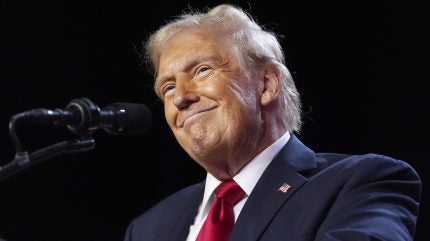
Trump 2.0 signals a seismic shift in US politics and will have significant ramifications for the rest of the world.
With the prospect of 10-20% tariffs on all US imports with measures for China set at 60%, a decoupling between Washington and Beijing set to accelerate and a rampant proliferation of the tech war, it’s clear we are set to see a more protectionist and disruptive administration. But how radical will Trump as the 47th US President be?
It looks like Trump will make good on his most commonly repeated campaign pledges – starting with a plan to upend global trade with a 10-20% baseline global tariff and a 60% (or higher) tariff on imports from China.
If implemented, the moves will cause serious disruption. Despite Trump’s assertions to the contrary, tariffs are paid by the companies or entities importing goods and not by the countries themselves. This means the cost of buying products from overseas, whether directly or as an input for manufacturing, would rise sharply, along with retail prices.
However, you can expect the rest of the world to devise retaliatory tariffs of their own. This level of intervention on both sides will likely start a new global trade war. Tariff hikes hitting all Chinese exports to the US could knock two percentage points from China’s potential GDP growth – the country’s global export market share is near an all-time high – unless Beijing responds with a stronger package of stimulus to its domestic demand.
Another form of retaliation from the rest of the world is market- rather than policy-based: namely, major world currencies weakening relative to the US dollar to offset the higher cost of exports to the increasingly protectionist country. An ever-strong US dollar – a prospect already showing up in the immediate market reaction to Trump’s election victory – runs contrary to the President-elect’s strategy of reviving the US manufacturing industry but is an inevitable consequence of his tariff strategy.

US Tariffs are shifting - will you react or anticipate?
Don’t let policy changes catch you off guard. Stay proactive with real-time data and expert analysis.
By GlobalDataWe are still in the very early innings of the AI revolution but the emergence of the technology is likely to be at the forefront of the continuing decoupling of the US and China and a tech war between the two countries.
It is already clear that a few core elements will drive the next ‘great game’ of superpower rivalry. These include advanced microchips, data centres, the energy to power the data centres and the trillions of dollars in capital flows to make this vision possible. On top of that, there are the critical minerals required to produce these inputs.
Yet with old economic models breaking apart and new ones not yet fully materialised, it is an open question which approach will prevail – that of a more positive tech trade policy of ‘running faster’ or the negative one of ‘tripping your opponent’.
Trump also wants to increase the oil and gas output of the US to reduce energy costs. While many of his other policies such as tariffs and tax cuts look inflationary for the US economy itself, this energy policy might produce an offsetting deflationary impact for the rest of the world and will potentially be good for consumer industries’ supply-chain costs.
Despite the shock of change, it should be noted that changes tend to happen at the margins and occur over time. The hope will be that the tough campaign talk on tariffs modulates into a reprise of Trump’s transactional approach during his previous administration when he used actual and threatened tariff hikes to extract concessions on trade and related economic matters such as exchange rates. In that case, a Trump 2.0 ‘trade war’ might yet prove relatively modest in scope.





